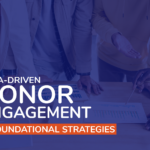Creating Auction Marketing Materials: 5 Storytelling Tips

Before your next auction rolls around, it’s time to ramp up your nonprofit’s marketing efforts once more. As new marketing trends emerge and old ones fall away, it can be challenging to know what to prioritize when creating compelling auction marketing materials.
By tapping into the power of storytelling, you can connect with your audience emotionally, thereby motivating action and support. We’ll provide five tips on how you can utilize storytelling to level up your nonprofit’s marketing materials and make a lasting impression. Let’s jump in.
1. Understand your audience.
By understanding your nonprofit’s audience, you can craft marketing materials that connect your mission to their specific interests and values.
Telling engaging stories about your nonprofit requires more than just broadcasting an overview of your mission and history to the world. It means tailoring your messages and narratives to resonate deeply with specific groups.
Consider the following donor data points:
- Age. Younger donors often engage more with social media and interactive platforms, whereas older donors might favor traditional channels like newsletters and emails.
- Occupation. Understand the professional backgrounds of your donors to better align your messaging. For instance, people working in creative fields might appreciate more visually-driven content, while those in the business or technical fields may prefer more data-backed content.
- Reasons for giving. Knowing why your donors support your cause can help you connect better. Some might give for personal reasons while others might be inspired to make a difference in their community. Use this knowledge to appeal to their specific motivations and emphasize how their support helps achieve these goals.
- Giving habits. Look at how often and how much your donors typically give. This can show you who might be most interested in attending and contributing to your auction or open to expanding their overall support, such as by becoming a monthly donor.
- Interests. Identify what your donors are passionate about outside of their support for your cause. This could be environmental issues, education, or arts. Knowing these interests can help you connect your organization’s goals with what your donors care about.
Let’s say your nonprofit focuses on promoting literacy and discovers that many of your donors are older teachers and parents in your community. With this in mind, you could include stories in your auction marketing materials that illustrate how your programs have helped kids learn to read. Additionally, you might highlight some reading-themed gift baskets among your auction items that might appeal to parents who want to encourage their children to read more. By focusing on what your donors care about, you can build stronger relationships and secure more support.
2. Incorporate compelling visuals.
Images are incredibly effective at capturing our attention quickly, much more so than text alone. This is because our brains process them almost instantly. That’s why incorporating graphics into marketing materials is so powerful, especially in today’s fast-paced world where people tend to skim rather than read in detail.
Simply adding a high-quality image or video can enhance your nonprofit’s content, whether it be a website page, flyer, or annual report. To appeal to more potential attendees before your next auction, consider incorporating the following visuals:
- High-resolution images of auction items. Showcase each item with clear, detailed photos that highlight the quality and unique features, making them more desirable to bidders.
- Video clips from past auctions. Include dynamic footage that captures the excitement and energy of live bidding, helping potential bidders feel the thrill and anticipate the experience.
- Interactive maps of the auction venue. Provide virtual tours or detailed maps that allow potential bidders to explore the space where the auction will be held.
- Infographics explaining the auction process. Use easy-to-understand infographics to guide newcomers through the steps of participating in the auction. These graphics can highlight key points like registration, bidding strategies, and payment options, providing a quick way for participants to grasp how everything works.
As you promote your auction, be consistent across all your marketing materials. In doing so, you can both reinforce your nonprofit’s identity and ensure that key messages are clearly communicated and remembered. To present a cohesive look through stories and visuals, Double the Donation recommends creating an official brand guide that defines your organization’s voice, font, colors, and image standards.
3. Adapt to each platform you use.
By using multiple platforms to share your auction marketing materials, you can maximize your reach and engage with a broader audience. Since each platform has its unique strengths and features, adapt your content to make the most of what the platform has to offer.
According to SchoolAuction.net’s silent auction guide, you should leverage the following channels to promote your upcoming auction:
- Email. Email campaigns allow for direct and personal communication with your supporters. Tailor your emails to include captivating narratives that share the stories behind the auction items or the impact of the funds raised.
- Social media. Social media platforms are excellent for creating visual content that can quickly capture attention and encourage sharing. Make sure you feature eye-catching images or videos of the auction items and use hashtags to increase visibility.
- Flyers. Flyers are a tangible way to reach local communities and can be highly effective when placed in strategic locations. Customize your flyers with vibrant graphics and concise information that highlights the key details of your auction. Incorporate QR codes that link directly to your auction page.
- Local news and press. Utilizing local news outlets can provide a significant boost in visibility within your community. Prepare compelling stories or interviews that resonate with the local audience, and provide high-quality images or videos that these outlets can use in their reporting.
To effectively evaluate and adjust your marketing strategies, track specific metrics on each platform you use. For email, this would include looking at how many people are opening your emails and clicking on links. For social media, look at engagement with your posts—such as likes, comments, and shares—as well as the reach (how many users see your content).
This approach will help you identify which efforts are successful and where adjustments may be necessary to improve your outreach.
4. Share past auction results.
Nonprofit auctions are exciting and entertaining events for guests. However, many guests are drawn to attend because they want to contribute to your impact. One way to appeal to these motivations is to share specific results of successful auctions in the past.
Let’s say your last school auction earned enough revenue to purchase interactive whiteboards for all of your classrooms. You could gather and share stories from teachers and students who have benefited from the whiteboards. For example, teachers could explain how the whiteboards have enhanced their instructional methods, allowing for more engaging lessons. Students could share stories about how these new tools have made learning more fun and accessible, perhaps through multimedia lessons or collaborative group projects.
You can also gather testimonials from attendees who had a rewarding experience at one of your past auctions. These anecdotes serve as powerful social proof, demonstrating to potential participants and donors the real-life impact and enjoyment brought on by the event. Be sure to gather feedback from a diverse group of past attendees and get consent from everyone before sharing their name or image.
5. Conclude with a call to action.
Stories that vividly illustrate the impact of your nonprofit’s work can spark interest and inspire action among prospective attendees. However, to maintain momentum, you need to turn interest into action by specifying the next steps potential attendees can take.
Here are some specific calls to action (CTAs) that you can include at the end of your auction marketing materials:
- Sign up to attend the auction. Encourage potential attendees to register by providing a simple, direct link to the sign-up page. Highlight any incentives for early registration, such as discounted tickets or exclusive previews of auction items.
- Send an eCard to invite friends and family. Facilitate the sharing of your event by offering customizable eCards that attendees can send to their networks. This not only extends your reach but also personalizes the invitation process, making it more likely for recipients to support your cause.
- Share the upcoming auction on social media. Encourage supporters to spread the word by sharing details of the auction on their social media platforms. Provide them with pre-written posts or clickable graphics that include essential information and appealing visuals of the auction items.
- Learn more about the auction’s goals and purpose. Invite prospective guests to delve deeper into the reasons behind your auction by directing them to a dedicated page on your website that details the objectives and the specific projects the funds will support.
To grab attention and prompt action, design CTAs to visually stand out in your marketing materials. Use bright, contrasting colors for buttons and links to ensure visibility against your email or website background. Position CTAs prominently and make them large enough for easy viewing and clicking. For printed materials like flyers, simplify the next step for your audience by incorporating QR codes that link to relevant pages or platforms.
By following these tips, you can create effective auction marketing materials that not only tell a compelling story but also drive meaningful participation. Once you’ve assembled and articulated your nonprofit’s stories, use your silent auction software to segment emails, create a dedicated event website, and send out promotional texts to your contact list. Taking these steps will set your next auction up for maximum engagement and support.


